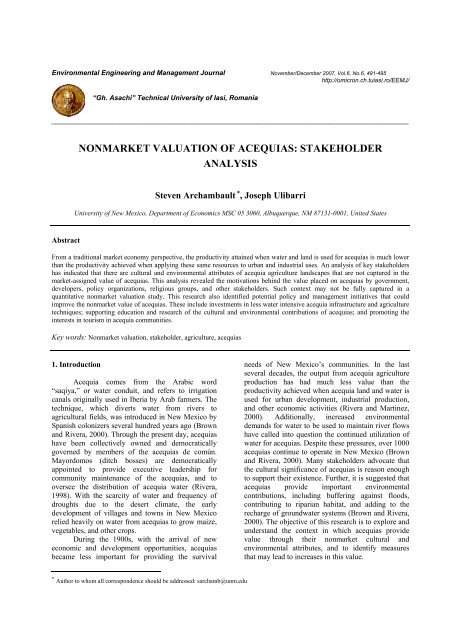2007_6_Nr6_EEMJ
You also want an ePaper? Increase the reach of your titles
YUMPU automatically turns print PDFs into web optimized ePapers that Google loves.
Environmental Engineering and Management Journal November/December <strong>2007</strong>, Vol.6, No.6, 491-495<br />
http://omicron.ch.tuiasi.ro/<strong>EEMJ</strong>/<br />
“Gh. Asachi” Technical University of Iasi, Romania<br />
______________________________________________________________________________________________<br />
NONMARKET VALUATION OF ACEQUIAS: STAKEHOLDER<br />
ANALYSIS<br />
Steven Archambault ∗ , Joseph Ulibarri<br />
University of New Mexico, Department of Economics MSC 05 3060, Albuquerque, NM 87131-0001, United States<br />
Abstract<br />
From a traditional market economy perspective, the productivity attained when water and land is used for acequias is much lower<br />
than the productivity achieved when applying these same resources to urban and industrial uses. An analysis of key stakeholders<br />
has indicated that there are cultural and environmental attributes of acequia agriculture landscapes that are not captured in the<br />
market-assigned value of acequias. This analysis revealed the motivations behind the value placed on acequias by government,<br />
developers, policy organizations, religious groups, and other stakeholders. Such context may not be fully captured in a<br />
quantitative nonmarket valuation study. This research also identified potential policy and management initiatives that could<br />
improve the nonmarket value of acequias. These include investments in less water intensive acequia infrastructure and agriculture<br />
techniques; supporting education and research of the cultural and environmental contributions of acequias; and promoting the<br />
interests in tourism in acequia communities.<br />
Key words: Nonmarket valuation, stakeholder, agriculture, acequias<br />
1. Introduction<br />
Acequia comes from the Arabic word<br />
“saqiya,” or water conduit, and refers to irrigation<br />
canals originally used in Iberia by Arab farmers. The<br />
technique, which diverts water from rivers to<br />
agricultural fields, was introduced in New Mexico by<br />
Spanish colonizers several hundred years ago (Brown<br />
and Rivera, 2000). Through the present day, acequias<br />
have been collectively owned and democratically<br />
governed by members of the acequias de común.<br />
Mayordomos (ditch bosses) are democratically<br />
appointed to provide executive leadership for<br />
community maintenance of the acequias, and to<br />
oversee the distribution of acequia water (Rivera,<br />
1998). With the scarcity of water and frequency of<br />
droughts due to the desert climate, the early<br />
development of villages and towns in New Mexico<br />
relied heavily on water from acequias to grow maize,<br />
vegetables, and other crops.<br />
During the 1900s, with the arrival of new<br />
economic and development opportunities, acequias<br />
became less important for providing the survival<br />
needs of New Mexico’s communities. In the last<br />
several decades, the output from acequia agriculture<br />
production has had much less value than the<br />
productivity achieved when acequia land and water is<br />
used for urban development, industrial production,<br />
and other economic activities (Rivera and Martinez,<br />
2000). Additionally, increased environmental<br />
demands for water to be used to maintain river flows<br />
have called into question the continued utilization of<br />
water for acequias. Despite these pressures, over 1000<br />
acequias continue to operate in New Mexico (Brown<br />
and Rivera, 2000). Many stakeholders advocate that<br />
the cultural significance of acequias is reason enough<br />
to support their existence. Further, it is suggested that<br />
acequias provide important environmental<br />
contributions, including buffering against floods,<br />
contributing to riparian habitat, and adding to the<br />
recharge of groundwater systems (Brown and Rivera,<br />
2000). The objective of this research is to explore and<br />
understand the context in which acequias provide<br />
value through their nonmarket cultural and<br />
environmental attributes, and to identify measures<br />
that may lead to increases in this value.<br />
∗ Author to whom all correspondence should be addressed: sarchamb@unm.edu


